When it comes to martial arts, people often think about the ways these deadly systems can be used to defeat opponents or how they can claim glory in the ring. Aikido is a much different system. It isn’t a martial art that is set out to break bones and add layers of glory to an Aikido gi.
The World Surrounding the Early Days of Aikido
Back before colorful Aikido belts littered international dojos, Japan was populated by martial art thugs. The old way of Jujutsu (Japanese combat arts) was for war – after all, the different styles of Jujutsu were designed for samurai fighting and killing for their daimyo.
Schools produced undisciplined students who ended up hurt one another during training or sparring. Jujutsu was unrefined and made solely for killing. It wasn’t until the new revolution of the 1900s that Jujutsu arts were altered for self-defense and sports.
Among these new martial arts were modern-day Karate, Judo, and Aikido. Aikido in particular emphasizes on self-defense.
Winning Without Hurting
Aikido’s founder, Morihei Ueshiba, points to an encounter he once had with a naval officer during a friendly duel. The naval officer was a fencing instructor and used a wooden sword to attack. Ueshiba evaded until the officer was exhausted and then took him down with a grab and throw.
It was at that point that Ueshiba realized martial arts could be altered to defeat an opponent without having to hurt them.
He could win without hurting, something that was never seen in Jujutsu. Back then, the only way to win was to break their joints (Judo) or strike them until they stop moving (Karate). Ueshiba’s philosophy would allow a defender to avoid harm but also avoid hurting someone else.
This is because Aikido focused more on using an opponent’s momentum against them. Such as in the case of Ueshiba fighting against the naval officer, an Aikido student could exhaust their opponent before using a single throw to win a match.
Diminishing the Advantage of Strength and Size
Judo is known for using its Judo gi as a means of making a fight fairer – by wearing a gi, both fighters will rely on their skills in the martial art instead of abusing their strength and size to overpower their opponent.
The same concept resides in Aikido albeit in a different manner. Ueshiba, who was a master of the Jujutsu art known as Daito-Ryu-Aiki-Jujutsu – refined his techniques so that even smaller, muscularly weaker fighters could win against much larger and stronger foes.
A smaller fighter could wait for his opponent to put all his weight in a single punch, step aside to avoid it, and then use that momentum to trip the opponent, grab him by his shoulder and then throw him down. It requires little effort and little strength to pull off.
Of course it requires a lot of training and the body needs to be at peace in order to master every technique and every move until it becomes instinctive. When the body reacts it should be automatic. In a fight there is little time to pause and think.
The Essence of Ki
Aikido is a martial art heavily imbued with the concept of Ki (chi). Ki is often expressed as the energy of the universe. Every person is surrounded by it, filled with it, and living through it. Aikido teaches a meaningful and harmonious path to achieve control of a person’s Ki.
The deeper philosophies of Aikido are not combined into a single religion or belief. Every Aikido school has their own spin on the arts’ philosophies and teachings but the essence remains the same: Aikido is a martial art that promotes peace of mind as it does control of one’s body.
When someone invades that zone of peace, Aikido teaches a path to restore it. When a woman is being assaulted by a rapist, Aikido will allow her to take down her opponent, even when he is large and armed, with neither of them getting seriously hurt.
This essence is why Aikido is not considered a combat art. While it is highly applicable for real world situations, it is not an art used for defeating several enemy soldiers in a war zone. It is only meant to be used for self-defense.
Aikido for Men, Women, and Children
Aikido appeals to men because of how flexible and applicable Aikido is in a real fight. It is appealing for children and women because it is a great way to defend oneself in real world situations such as when a person is being mugged or assaulted.
People wearing an Aikido gi are people to be respected. True Aikido students not only master the movements but instill the philosophies of peace and self-defense, making them some of the most respected fighters in the world today.
